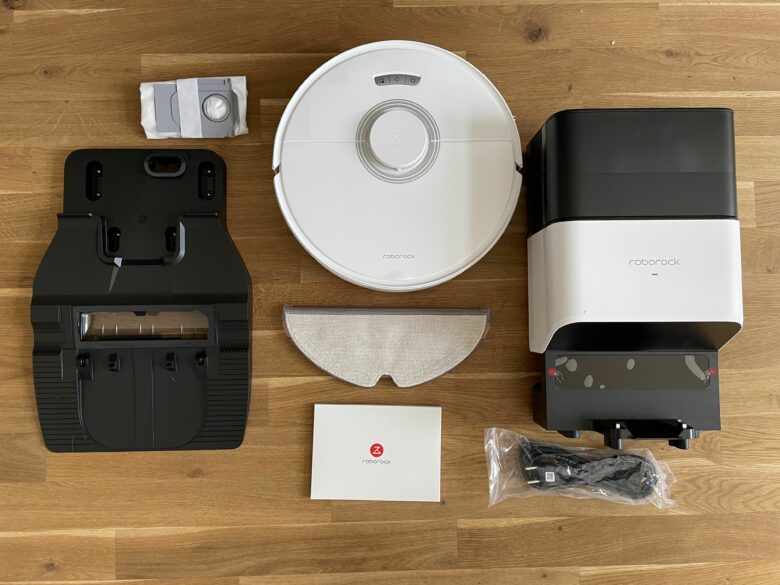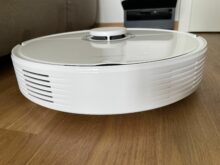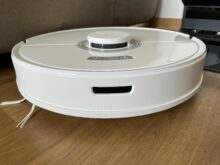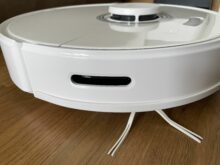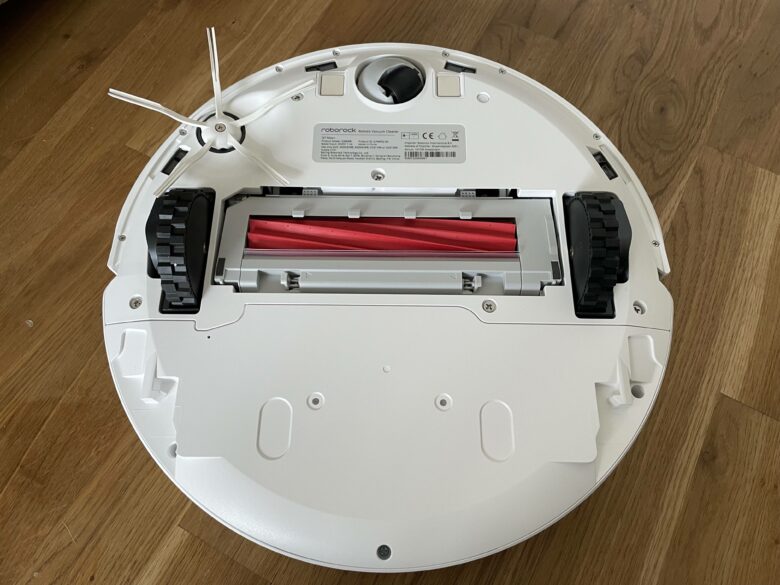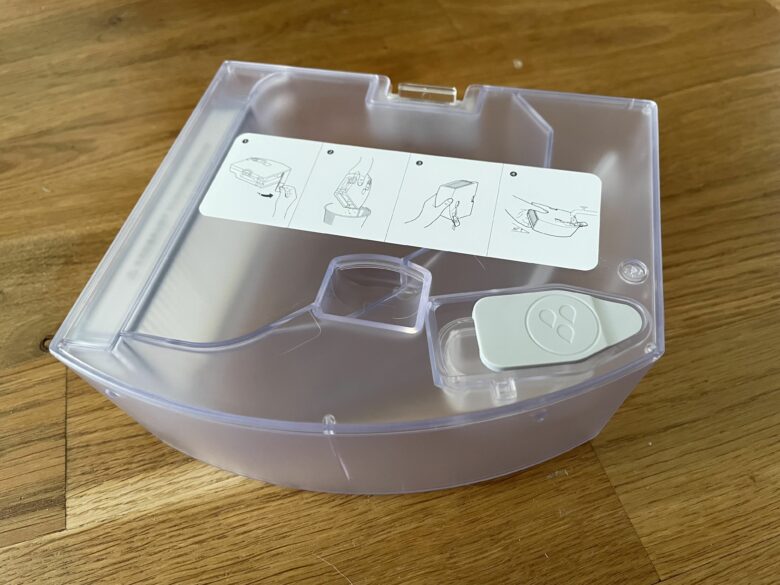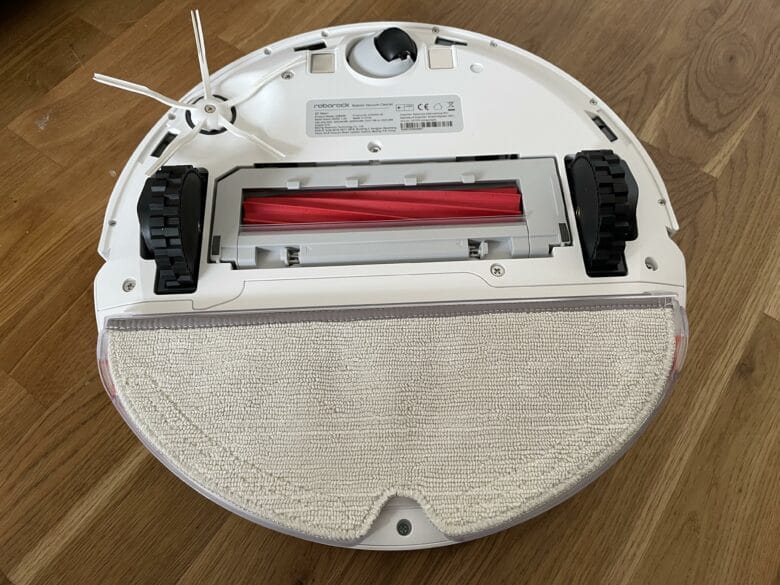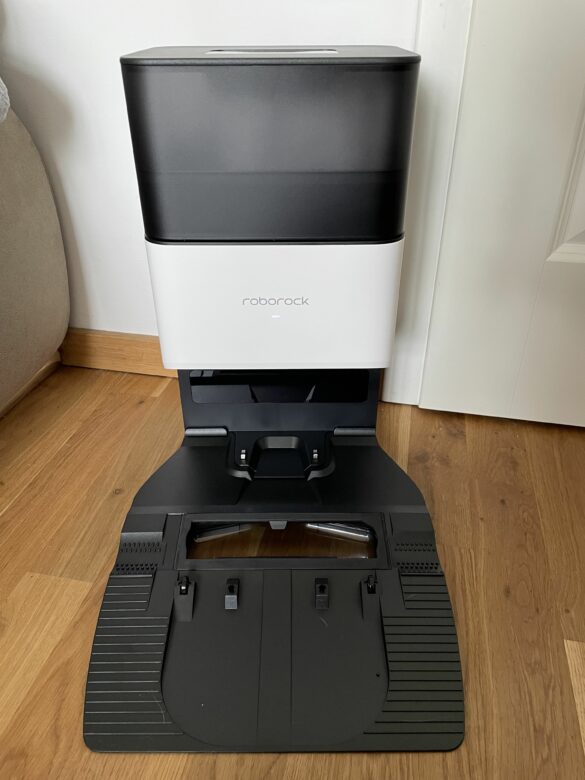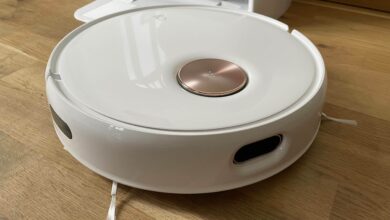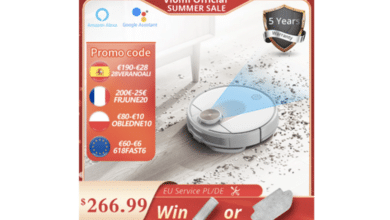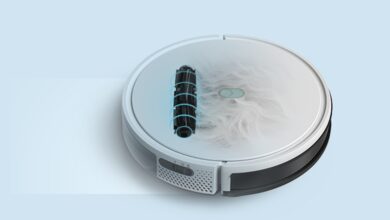The market for robot vacuums is growing and thriving. After all, for many people a smart household helper is an inexpensive alternative to a humanoid household worker. Although the mobile vacuums can only take care of the cleanliness of floors so far, who knows what else is in store. Accordingly, there are many providers on the wide-ranging robot vacuum market. While only expensive representatives from Western manufacturers like iRobot were available in the beginning, cheaper models have also been available for quite some time. New devices that score points with their value for money regularly come from the Far East in particular. Roborock belongs to the rather high-priced representatives from China.

The Xiaomi subsidiary proved last year with its Roborock S7 (test) what a nearly perfect vacuum robot with mopping function looks like. However, the whole thing also had its price. However, the manufacturer wants to prove that Roborock can also be mid-range with its Roborock Q7 Max+, which was introduced at the beginning of March. On paper, the overall package reads exceedingly well. In addition to the powerful vacuum robot itself, which is supposed to catch even stubborn dirt thanks to 4,200 pa suction power, there is also a practical suction station. This is supposed to make the use of the robot vacuum even more convenient. We want to take a closer look at the new mid-range device from Roborock today.
Technical details
| Model | Roborock Q7 Max+ |
| Colors | Black, White |
| Cleaning functions | Vacuuming and wiping |
| Suction power | 4,200 pascals |
| Navigation | LiDAR sensor, crash sensor, IR sensor, bumper |
| Mapping | Up to four floors 3D mapping |
| Capacity | Combination tank in the robot vacuum cleaner: 370 ml + 470 ml, suction station: dust bag with 2.5 l |
| Control | Control panel on the robot vacuum cleaner, voice control and app control |
| Cleaning time | 180 minutes |
| Battery capacity | 5,200 mAh |
| Volume | 67 decibels |
| Price | € 429.00 * |
Our expectations
Anyone who knows a little about the segment of modern vacuum cleaners, can not help but know Roborock. Yet the company has always tended to stand for premium devices. This applies to both cordless vacuums and vacuum robots. We are all the more curious to see how the Q7 Max+ performs as a designated mid-range device. Basically, it is a slimmed-down version of the flagship Roborock S7 MaxV Plus. The locking tip from the company’s own ranks scores in every discipline, except for the price. Consequently, we also immediately identified the target group for the Q7 Max+. Roborock wants to address all those who do not want to pay just under 1000 euros for a vacuum robot plus suction station.
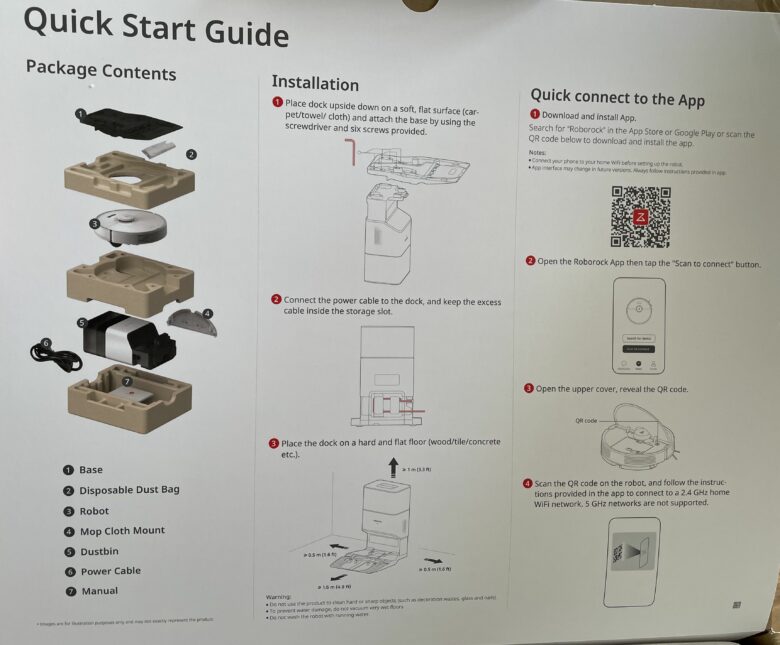
It is precisely the mentioned suction station that has virtually ushered in a new era in the field of robot vacuum cleaners. After all, this allows you to stop emptying the dust bin of your robot vacuum cleaner every few days. Roborock states that the Q7 Max+ only needs to be emptied every seven weeks. Accordingly, using a robot vacuum cleaner with the addition of a suction station becomes even far more convenient than it already is. In addition to the suction station, the Q7 Max+ also offers a mopping function. We want to check whether the price difference of about 350 euros compared to the S7 MaxV Plus also results in noticeable differences in performance.
The scope of delivery
A look inside the cube-shaped box of the Q7 Max+ also reveals other practical accessories in addition to the vacuum robot itself. On the one hand, there is the suction station as well as another dust bag for the same. Furthermore, we find the mop plate with matching mop cloth and, of course, the usual paperwork like user manual and warranty card.
Design and finish
As an owner as Roborock S7, I have always liked the design language that the company speaks. In particular, I have grown to love the combination of white and the colorful orange-red accents. We were also sent the Q7 Max+ in our test version in the color white. Alternatively, however, you can also purchase the robot vacuum in the color black. Compared to the S7, the Q7 Max is more restrained. For example, the LIDAR sensor is no longer in a bright orange color, but in a restrained black. Only details, such as the buttons for removing the wiper holder, shine in an eye-catching color.

In the white version, the suction station comes in a combination of black and white. The black Q7 Max+ is a different story. Here, Roborock relies on a combination of black and gray for the station. Admittedly, I would have found a pure white suction station nicer. But that is a matter of taste and is therefore left out of the rating. Much more important is the build quality. This is on the highest level. I cannot determine any differences compared to the Roborock S7. It doesn’t creak at any point and everything feels wonderfully high-quality.
Well-known curves
Roborock also relies on its usual rounded design for its Q7 Max+. This is hardly surprising, given its advantages in the field. After all, the circular vacuum robot tends to get stuck far less than a square counterpart would. Looking at the top of the device, you can also see the iconic turret, which sits loftily on top of the vacuum slightly offset from the center. Hidden in here is the LIDAR technology, whose laser module is now black instead of orange.
Furthermore, the device buttons are located here, which can be used as an alternative to the app as a control unit. The silver buttons let you turn the Q7 Max+ on and off, return to the suction station or clean the current perimeter. On top of that, parents can conveniently activate a child lock here, which prevents input via the buttons. Opposite the LIDAR tower and buttons is the tried and true Roborock logo.
A combo bin for wiping water and dust
So far, so familiar. However, the vacuum cleaner reveals differences when you take a look under the hood. Roborock has obviously chosen a different layout here. While the S7 has a separate water tank and dirt container, the manufacturer uses a combination solution for its mid-range model. Water tank with 370 ml capacity as well as dust container with 470 ml volume are now in one container.
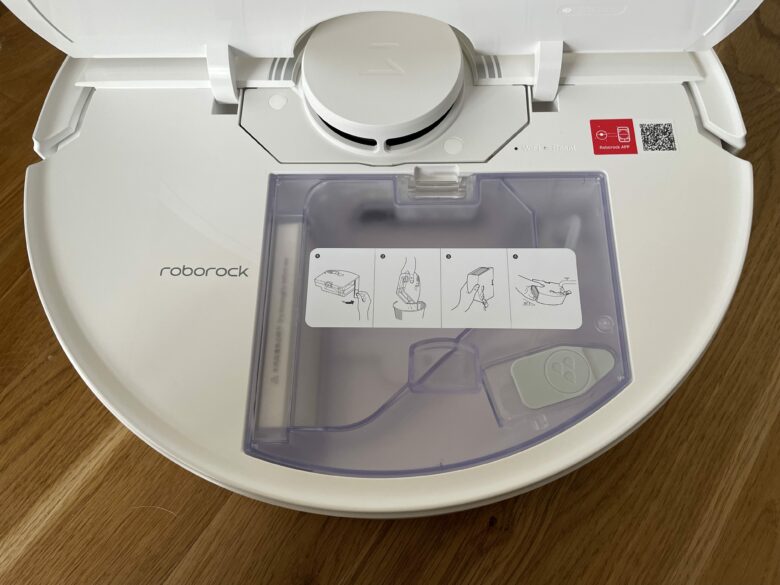
Personally, I’m curious to see how this rethink will fare in practice. After all, I’m a big fan of being able to fill up wiper water on the S7 without having to open the flap. That’s not all the changes, by the way. Furthermore, Roborock does away with a cleaning tool that usually finds its place under the hood. However, you don’t really need it in view of the reworked main brush.
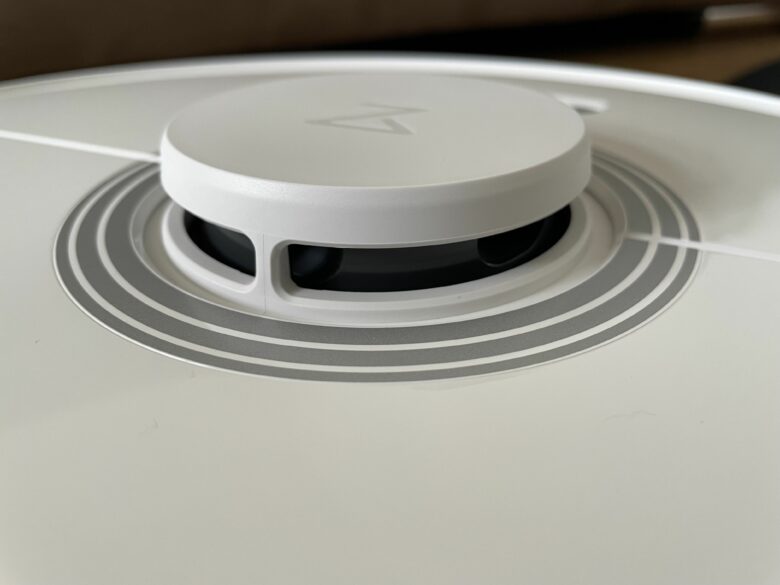
Since this now dispenses entirely with individual brushes and instead relies on rubber fins, nothing at all can get caught here. Roborock has unceremoniously placed its own logo here so that the free space doesn’t look too “naked”. Otherwise, you’ll see the usual technology inside. Besides the LED for the WIFI status, there is also a reset button for resetting the device. Thanks to the handy QR code, you can also download the app directly. But more about this later.
Removal of modern sensors
If you take a look at the device from the side, you can clearly see for the first time where Roborock has saved. Namely, while the S7 has optical obstacle detection, the Q7 Max+ relies on reliable, but now somewhat outdated IR technology.
This is located on the side of the impact protection. Furthermore, there is a special sensor there that is supposed to detect walls. Otherwise, in the side view there are only the slots for the discharge of exhaust air to see.
Reliable main brush
You don’t have to do without the maintenance-free main brush of the Roborock S7 in the Q7 Max+ either. This impresses in particular by the material. Instead of vulnerable dirt traps in the form of classic bristles, the manufacturer relies here namely on several slats that are made of rubber.
So you don’t have to worry about wedged pet hair or the like here. Roborock also relies on rubber again for the side brush. On closer inspection, you can also see the sensors here, which are intended to prevent falls of the robot vacuum cleaner.
Light and dark sides of the combi bin
.
It was a bold decision by Roborock to combine water and dust container in a combi solution. In particular, the huge volume brings great advantages. After all, the nickname “Max” is no accident. However, it is questionable whether this volume is actually needed in view of the regular emptying by the suction station. It might have made more sense to make the water tank a bit larger instead.
In practice, I found that the dust bin empties much cleaner than it does on my S7. When it comes to filling the water reservoir, as I said, I’m ambivalent, as I prefer separate solutions. However, since you cannot hide the Q7 Max+ under a cabinet or other piece of furniture anyway, it should be possible to open the hood at any time to remove the reservoir. The water, by the way, can be refilled quite easily by opening the rubber cap.
Wiping plate at the bottom
With the wiping plate itself, parallels to the Roborock S7 can again be seen. Here, the manufacturer once again relies on a foolproof installation on the underside of the device. Once inserted into the guide rail, a click along with a friendly voice indicates that the wiping unit has been installed. Conversely, all you have to do is press and pull the two orange buttons to remove it. This operation is also confirmed by the robot via voice output. So, depending on whether you install the wiper unit or not, the squeegee will register this.
When the unit is installed, the attached wiper cloth is permanently moistened by water nozzles of the wiper water tank. If you decide not to mount the wiping unit, no water will flow through the openings either. By the way, the mop unit of the Q7 Max+ once again features the special spring technology of older flagships from Roborock. Here, the mop is not simply dragged across the floor, but is sprung with a whopping 300 grams of pressure on the floor. This is said to provide more efficient cleaning.
Suction station is anything but middle class
Wiping function and LIDAR technology have now also arrived in the mid-range at other manufacturers. However, the extraction station offered by the Q7 Max+ hardly has anything to do with mid-range. It is the one that gets the maximum comfort out of the robot vacuum. Let’s take a closer look inside.
The so-called “Pure” has a dust bag. This is essential for operation. After each cleaning tour, the Q7 Max+ returns to the extraction station. Once there, the “Pure” sucks the collected dirt back out of the robot vacuum. This is then collected in a container with a proud 2.5 liter volume.
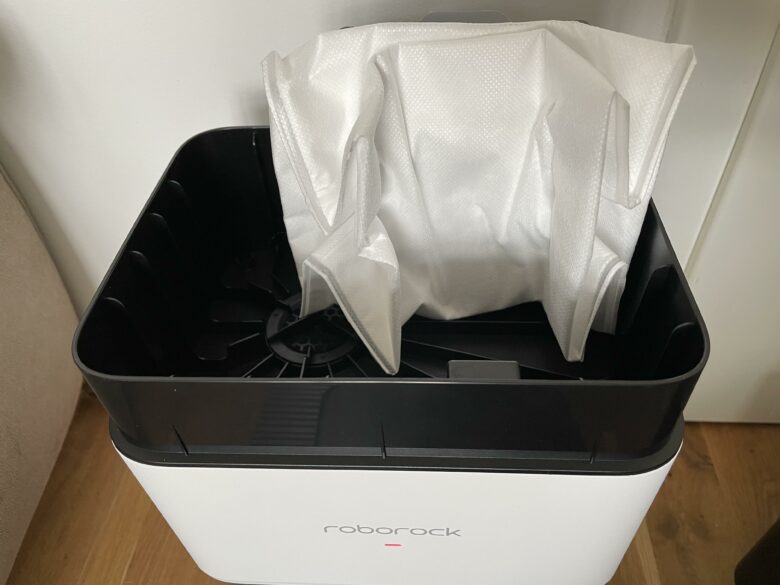
According to Roborock itself, the bag should be able to last seven weeks until it’s time to empty it. Even high-end robotic vacuum cleaners have to be emptied once a week, depending on the amount of dirt and the size of the apartment. This clearly shows how practical such a suction station is. However, it is also the sheer size of the station that is the Achilles’ heel.
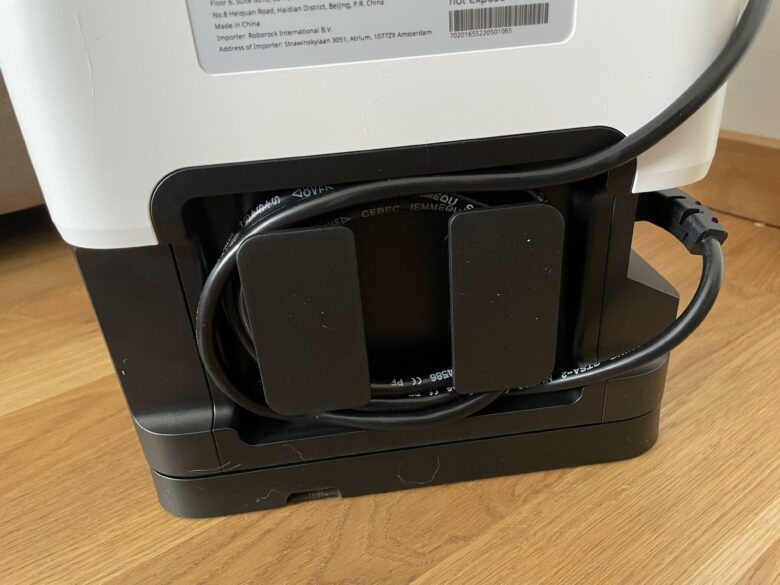
If, like me, you like to hide a vacuum robot under flat furniture, you should be aware that this is not possible with the Q7 Max+. However, since Roborock hides an extensive cable management on the back here, you can at least be happy that everything looks tidy.
Good orientation thanks to LIDAR
As already mentioned, the laser technology for the so-called LIDAR navigation is hidden under the small turret of the Roborock Q7 Max+. This ensures that the vacuum cleaner finds its way around your own four walls. As part of its cleaning tour, it usually first travels around the edges of a room and then cleans the center of the room in classic S-curves. This may seem a bit awkward during the first run. However, you should not be put off by this. After all, the vacuum cleaner first has to create a map of the surroundings before it can drive according to the system. The real-time detection is particularly impressive. For example, the device registers furniture or other obstacles that have been added right away and remapped them directly.
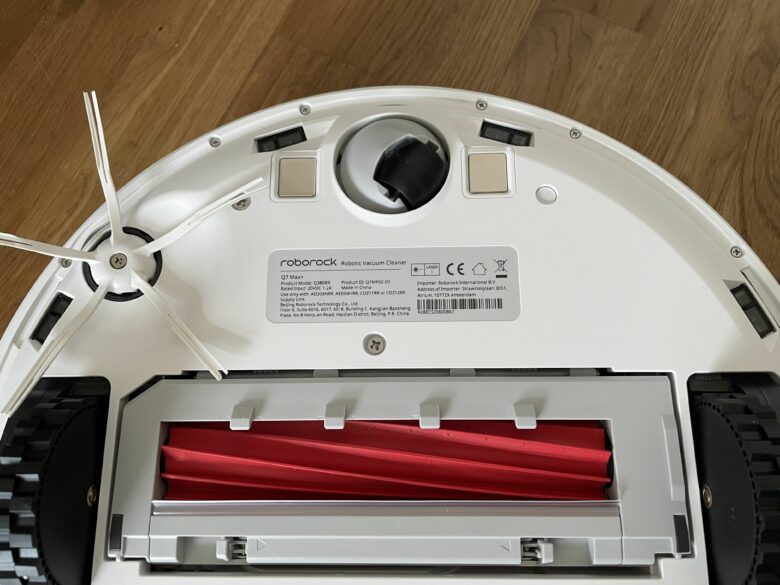
The only flat obstacles that the Q7 Max+ cannot detect right away are books that have been left lying around. Here, a collision is usually unavoidable. This is because the mid-range device “only” has infrared sensors and no optical sensors to detect obstacles. However, it always reliably stopped in front of walls or furniture. Here, the blocking tips of the Roborock lineup are superior after all. The other sensors, on the other hand, do a very good job. Thanks to fall sensors, you don’t have to worry about falling down stairs, and a sensor on the laser tower prevents it from getting stuck under furniture. Everyone has a break – even a vacuum robot. Once the Roborock Q7 Max+ has completed its cleaning tour, it returns to its charging and suction station. In the test, it always managed to do this reliably. There were no stray trips.
The practical test
After all the theory, it’s now down to the nitty-gritty. The supreme discipline of any robot vacuum cleaner is, of course, its cleaning performance. Since the Q7 Max+ has a suction and wiping function, we naturally want to take a look at both capabilities. The smart household helper definitely has a reputation to lose here. After all, Roborock’s devices actually stand for very good cleaning. We are curious.
The suction test
First, let’s take a look at the most important function – vacuuming. A look at the data sheet gives us a lot of hope here. After all, the Q7 Max+ offers decent power under the hood with a suction power of 4,200 pa. Of course, one should not forget that a great performance is not much use if the device cannot implement it. And the Q7 Max+ can really do that. The suction power convinced me from the first minute on every floor. I was able to observe its performance on parquet floors, tiles and carpet.
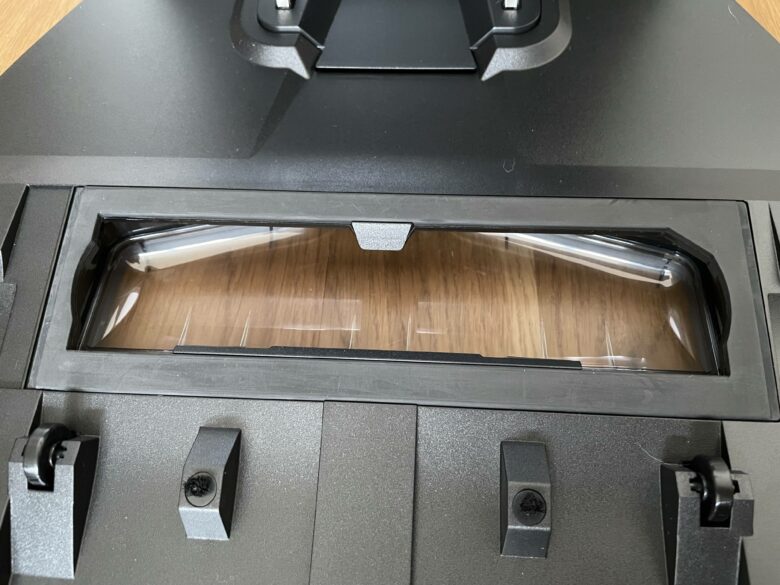
I assume that the special design of the maintenance-free main brush in particular ensures that the Q7 Max+ can transfer its power to the floor in the best possible way. Since this tailors itself to the ground, a vacuum-like condition is achieved here. Even my challenging long pile carpet could not stop the robot vacuum. Thanks to the carpet detection, it immediately switched to the strongest level here and left behind a very clean surface. In the area of vacuuming, the new mid-range model consequently gave me no reason to complain.
The wipe test
While a mopping function is nothing more than a “nice to have” for many robot vacuum manufacturers, Roborock has managed to take combi devices to the next level with its flagships. Among other things, the special spring mechanism is responsible for this, which does not simply keep the wiping cloth flat on the floor, but lets it perform real wiping movements. We already know the technology used in the Q7 Max+ from flagships that are a bit older by now, such as the Roborock S5 Max.

Meanwhile, Roborock offers a new level of wiping performance with its S7, which relies on vibration technology. Consequently, the wiping result of the mid-range device cannot keep up with the current flagship either. However, this does not mean that the wiping performance is bad at all. Rather, it can be seen as a perfect complement to the suction process. After all, it collects the fine-pored dust that the vacuum leaves lying around. Unlike the S7, however, I would not send the Q7 Max+ on a sole mopping tour through the apartment. The mopping performance is not effective enough for that. But the Q7 Max+ also has a decisive advantage over the S7.

Namely, while I have to moisten the wiping cloth on my flagship before every new wipe, the water nozzles on the mid-range model ensure that the entire wiping cloth is wet after just a few seconds. This enables the squeegee to really use the entire width of the wiping surface. By the way, the Roborock Q7 Max+ is supposed to last up to 180 minutes in total. In view of the 5,200 mAh battery, I find this quite realistic. Of course, you always have to assume the lowest performance level. However, the robot vacuum should certainly manage even large apartments in one cleaning run.
Siri is Roborock’s best friend
When we talk about smart household helpers, we naturally also have to talk about the corresponding features. On the Q7 Max+, there’s the option of voice control, for one. With the support of the usual suspects (Alexa, Siri and Google Assistant), the robot vacuum cleaner can be controlled quite easily via voice command in its own network. At least in theory.

I tried Alexa and Siri and was disappointed by Amazon’s assistant. In particular, the range of functions was very small here. Perhaps Roborock or Amazon will upgrade again here. Things looked different with Siri in the test. Apple’s AI got along very well with the Q7 Max+. For example, I was able to send it specifically into rooms.
Huge scope in the Roborock app
As a user of the Roborock S7, the app is not new to me. That’s why I felt right at home. However, those who have not yet added a Roborock device to the app will have to get used to having to create an account. I always find this annoying, but nowadays this is the case with almost every provider. In terms of functionality, no one can really complain here. I would like to explain just a few highlights in more detail.

First, there is the mapping of the robot vacuum. With the help of LIDAR technology, the Q7 Max+ creates a detailed floor plan of your own four walls. Especially cool: Within the app, your apartment is automatically divided into different rooms. If this does not work due to an exotic floor plan, you can easily adjust it within the app. The division allows you to clean individual rooms in a targeted manner. Especially in the kitchen, it can be quite necessary that the robot vacuum cleaner goes on a cleaning tour several times a day.

Within the map, you can then make different adjustments. For example, furniture can be inserted to encourage the robot vacuum to drive around it at a sufficient distance. You can also assign a specific floor type to each room. Owners of a house or a multi-story apartment will also be pleased to know that four different floors can be saved in the app. This means that the Q7 Max+ can also be used on several floors.
Individual cleaning
However, since vacuum robots can’t climb stairs (yet), you’ll naturally have to carry it back and forth between floors. Within the app, you can set each cleaning trip individually. On the one hand, you can freely select the locations to be cleaned. You can clean the entire apartment or a specific zone. The latter can be drawn on the map in the app. While the Q7 Max+ is making its rounds through your apartment, you can track it in real time in the app.
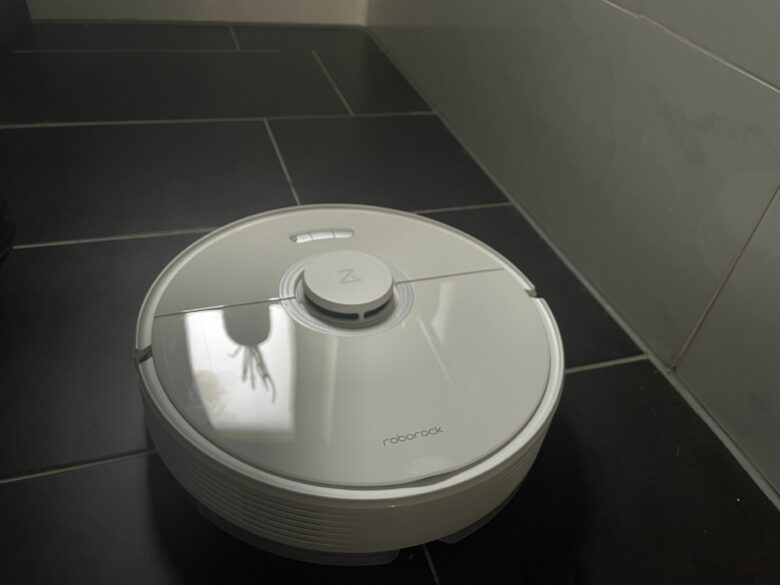
Of course, the strength of the suction power and wiping function can also be regulated. While you can choose between four different levels of suction power, you have 30 different levels to choose from when wiping. Tile floors, for example, are best suited for the maximum water supply. For wooden floors, on the other hand, you should choose a lower level. Just like you can set targeted cleaning zones, you can also select exclusion zones within the app. The robot vacuum will not enter these.
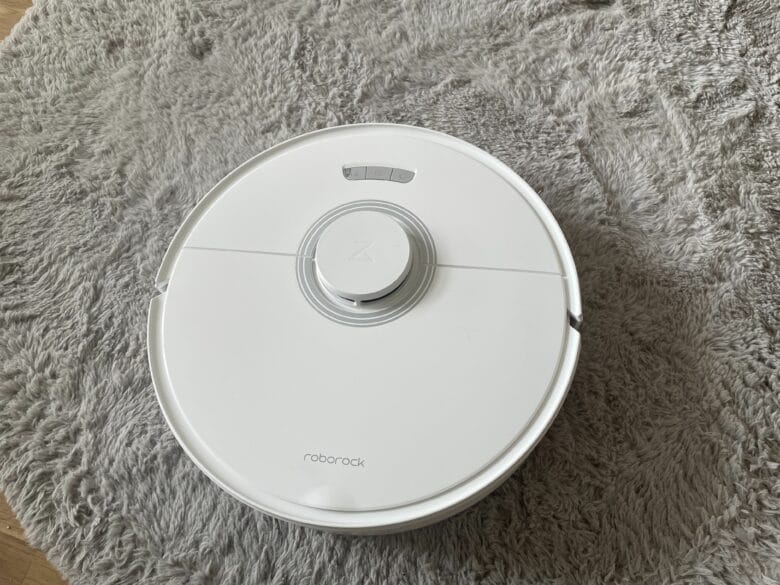
On top of that, you can regulate in which areas it should deactivate the wiping function. This is quite useful. Unlike the Roborock S7, the Q7 Max+ cannot lift its wiping cloth. Therefore, you should completely disable the wiping function in areas with carpeted floors. By the way, you can also adjust the work of the suction station within the app. Not only can it be activated or deactivated. On top of that, you can regulate the suction power.
Remote-controlled car for adults
If you enjoyed playing with remote-controlled cars as a child, then you will certainly enjoy the Q7 Max+. After all, you can maneuver the robot vacuum through your home like a remote-controlled car with the help of the app. In practice, however, this is more of a small gimmick without any real added value. However, I found it convenient to let the robot vacuum drive in front of my feet when I want to remove the dust bin. Furthermore, I can imagine that the feature can be handy if the robot ever gets lost under a piece of furniture. However, in the course of my test, this never happened.
Conclusion: More upper class than middle class
In the test, the Roborock Q7 Max+ left a very positive impression on me. On the one hand, this is due to the uncomplicated operation. You can control the robot vacuum either using the buttons on the robot itself or via the Roborock app. However, everything stands and falls with the cleaning performance of robotic vacuum cleaners. And this is where the Q7 Max+ really delivers. Especially in the main discipline, vacuuming, I simply have no reason to complain. This is certainly due to the combination of the strong 4,200 pa suction power and the maintenance-free main brush with rubber blades.

In terms of wiping performance, however, you can see that the Q7 Max+ is a mid-range device. This cannot stand out noticeably from the competition and lags far behind the Roborock S7. The suction station, which stands for the “+” in the name, rounds off the overall package. It is simply exceedingly practical that you only have to empty the dirt bin about every seven weeks. All in all, the Q7 Max+ is a mid-range device that should rather be assigned to the upper class. Not only the performance speaks for this, but unfortunately also the price.
Roborock Q7 Max+
Workmanship
Suction power
Wiping performance
Value for money
90/100
With the Q7 Max+, Roborock proves that mid-range and very good performance are by no means mutually exclusive. Here you get the most important features and power of the flagships for a much lower price.
